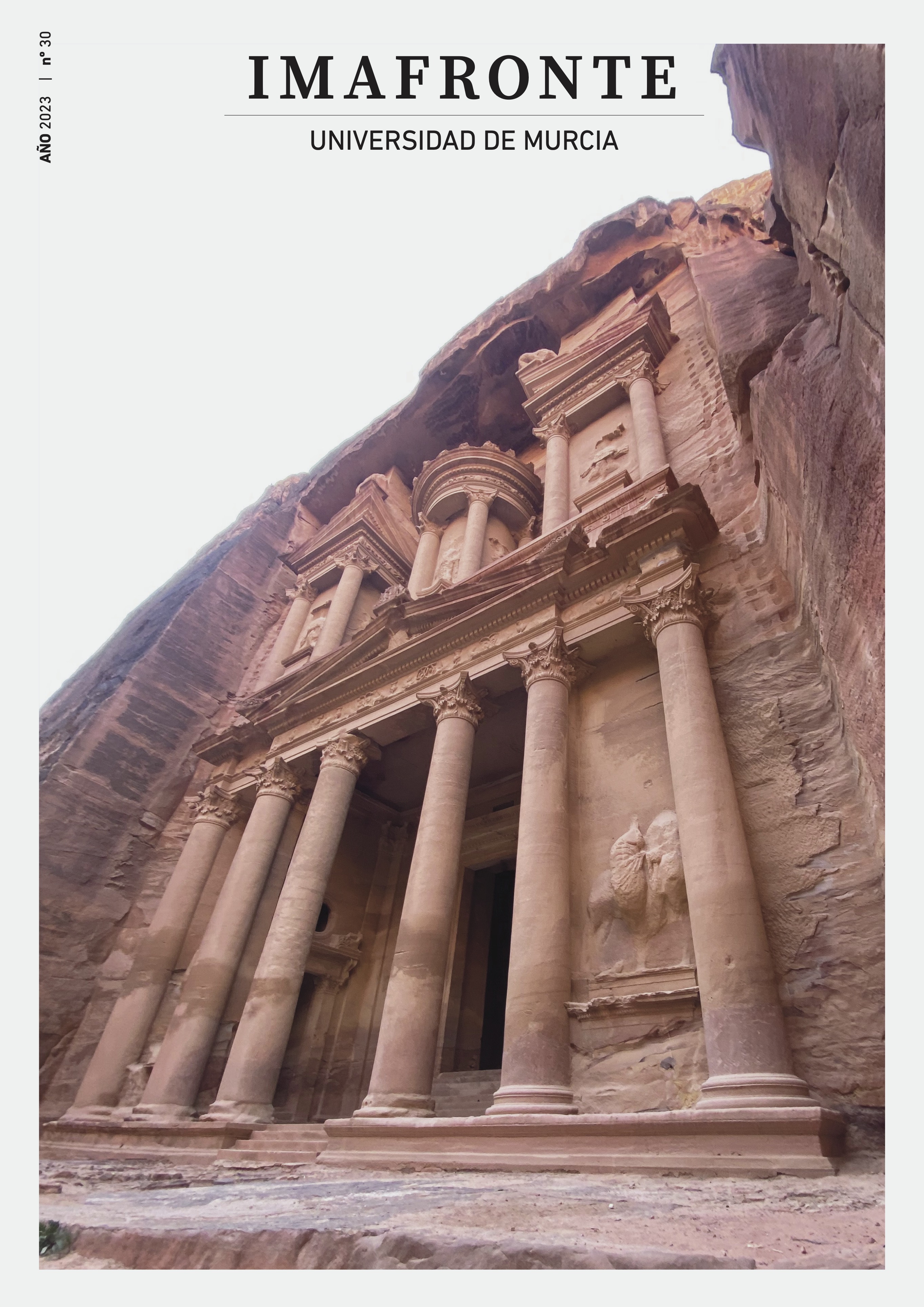From visualization to the worshipper’s touch. Approaching the physical interaction with the greek herms
Abstract
In this paper, I underline the importance to focus not only on the visual but also the physical interaction with the Greek divine image called ‘herm’. On the basis of its bifunctionality, and based on the iconographic and literary evidence, I intend to give a brief interpretation of the meaning of the direct physical contact with this statue, probably linked to a ritual primary functionality and to his ubiquitous presence. Finally, I suggest the adoption of the term "toucher-worshipper" as useful to refer to the ancient comprehension, assimilation, and perception of the semi-iconic visual language and the embodied divine identity.
Downloads
-
Abstract944
-
PDF (Español (España))507
-
EPUB (Español (España))335
References
Allan, A. (2018). Hermes. London-New York: Routledge.
Ballesteros, S. (1993). “Percepción háptica de objetos y patrones realzados: una revisión”. Psicothema, 5, n. 2, 1993, pp. 311-321.
Bettinetti, S. (2001). La statua di culto nella pratica rituale greca. Bari: Levante.
Collard, H. (2019). “Communicating with the Divine: Herms in Attic Vase Painting”. En J.F. Miller & J. Strauss Clay, Tracking Hermes, Pursuing Mercury. Oxford: Oxford University Press, 227-244.
Collignon, M. (1911). Les Statues funéraires dans l'Art grec. Paris: Ernest Leroux.
Crome, J. F. (1935/1936). “Hipparcheioi Ermai”. AM, 60–61, 300-313.
Curtius, L (1903). Die Antike Herme. Eine Mythologisch-Kunstgeschichtliche Studie. Leipzig: Druck von B.G. Teubner.
Delattre, C. (2007). “La statue sur le rivage: récits de pêche miraculeuse”. En Objets sacrés, objets magiques de l’Antiquité au Moyen Age, editado por C. Delattre, 65-82. Picard.
Devambez, P. (1968). “Piliers hermaïques et stéles”. Revue Archéologique, 1, 1968, pp. 139-154.
Doyle, J. (2020). “All of a Heap. Hermes and the Stone Cairn in Greek Antiquity”, in Cultures of Stone. An Interdisciplinary Approach to the Materiality of Stone edited by G. Cooney – B. Gilhooly – N. Kelly – S. Mallía, 261-272. Leiden: Sidestone Press.
Fredal, J. (2002). “Herm Choppers, the Adonia, and Rhetorical Action in Ancient Greece”. College English, 64, n. 5, 590–612.
Frontisi-Ducroux, F. (1986). “Les limites de l'anthropomorphisme: Hermès et Dionysos”. En Corps des dieux edited by C. Malamoud & J.P. Vernant, 193-211. Paris: Gallimard.
Frontisi-Ducroux, F. (1991) Le Dieu-Masque: une figure du Dionysos d'Athènes. Paris-Rome: La Découverte - Ecole Française de Rome.
Furley, W. D. (1986) Andokides and the Herms: A Study of Crisis in fifth-century Athenian Religion (Bulletin of the Institute of Classical Studies. Supplement; 65). London: University of London.
Goldman, H. (1942). “The Origin of the Greek Herm”. AJA, 46, 58-68.
Harrison, E. B. (1965) Archaic and Archaistic Sculpture (The Athenian Agora vol. 11). Princeton: American School of Classical Studies at Athens.
Hedreen, G. (2014). “The Artificial Sculptural Image of Dionysos in Athenian Vase Painting and the Mythological Discourse of Early Greek Life”. En A. Avramidou & D. Demetriou, Approaching the Ancient Artifact: Representation, Narrative, and Function. A Festschrift in honor of H. Alan Shapiro Berlin-Boston, 267-280.
Anonimizado 2023
Jaillard, D. (2001) “Le pilier hermaïque dans l'espace sacrificiel”. Mélanges de l'École Française de Rome. Antiquité, 113, 341-363.
Lacroix, L. (1949). Les Reproductions De Statues Sur Les Monnaies Grecques: La Statuaire Archaique Et Classique. Liége; Paris: Faculté de Philosophie et Lettres.
Lissarrague, F. (2022). “Writing on Architectural Structure”. En Image, Text, Stone: Intermedial Perspectives on Graeco-Roman Sculpture, edited by Dietrich, Nikolaus and Fouquet, Johannes. Berlin, Boston: De Gruyter.
Lullies, R. (1931). Die Typen der griechischen Herme, Königsberg: Gräfe and Unze.
May, J. M. (1950). Ainos: Its History and Coinage. Oxford; London: Oxford University Press; G. Cumberlege.
McNiven, T. J. (2009). "Things to Which We Give Service: Interactions with Sacred Images on Athenian Pottery". En An Archaeology of Representations: Ancient Greek Vase-Painting and Contemporary Methodologies, edited by Dimitrios Yatromanolakis. Athens: Institut du Livre A. Kardamitsa, 298-325.
Mylonopoulos, J. (2010). “Divine Images versus Cult Images: An Endless Story about Theories, Methods, and Terminologies”. En Divine Images and Human Imaginations in Greece and Rome, edited by J. Mylonopoulos, Leiden-Boston, 1-20.
Nilsson, M. P. (1940). Greek Popular Religion. New York: Columbia University Press.
Osborne, R. (1985). “The erection and mutilation of the Hermai”. Proceedings of the Cambridge Philological Society.
Petrovic, I. (2010) "The life story of a cult statue as an allegory: Kallimachos’ Hermes Perpheraios", in Divine Images and Human Imaginations in Ancient Greece and Rome, edited by Joannis Mylonopoulos. Leiden: Brill, 205-224.
Rückert, B. (1998). Die Herme im ö ffentlichen und privaten Leben der Griechen: Untersuchungen zur Funktion der griechischen Herme als Grenzmal, Inschriftenträ ger und Kulturbild des Hermes. Regensburg.
Shapiro, H. A. (1989). Art and Cult Under the Tyrants in Athens. Mayence, Ph. von Zabern.
Steiner, D. (2001) T. Images in Mind: Statues in Archaic and Classical Greek Literature and Thought. Princeton: Princeton University Press.
Tanner, J. (2009). The invention of art history in ancient Greece: religion, society, and artistic rationalisation. Cambridge: University Press.
Tekin, O. (2021). “Parasema of the two cities on their coins and weights: The Lion of Lysimacheia and the Hermes Throne of Ainos”. En Thrace – Local coinage and regional identity, edited by Ulrike Peter, Vladimir F. Stolba. Berlin: Topoi Edition, 115-123.
Tomás García, J. (2017) “Definición y contextos de las imágenes de culto en la Grecia antigua”. Euphrosyne, 45, 25-40.
Versnel, H. S. (2011). Coping with the gods. Wayward readings in Greek Theology. Leiden-Boston: Brill.
Weddle, P. (2010). Touching the Gods: physical interaction with cult statues in the Roman world. Durham University: Doctoral thesis.
Willers, D. (1967). “Zum Hermes Propylaios des Alkamenes”, JDAI, 82, 37-109.
Zanker, P. (1965). Wandel der Hermesgestalt in der Attischen Vasenmalerei. Bonn.
Copyright (c) 2023 Pelayo Huerta Segovia

This work is licensed under a Creative Commons Attribution-ShareAlike 4.0 International License.
1. The authors non-exclusively assign the exploitation rights (reproduction, distribution, communication and transformation) to the magazine.
2. The works published in this magazine are subject to the Attribution-ShareAlike 4.0 International license (CC By SA 4.0). Therefore, they can be copied, used, disseminated, transmitted and publicly displayed, provided that:
i) the authorship and the original source of its publication (journal, editorial and URL of the work) are cited, thus allowing its recognition.
ii) it is allowed to remix, transform or create from the material while maintaining the same license as the original.

3. Self-archiving conditions. Authors are allowed and encouraged to electronically disseminate the pre-print (version before being evaluated) and/or post-print (version evaluated and accepted for publication) versions of their works before publication, as it favors their publication. Earlier circulation and diffusion and with it a possible increase in its citation and reach among the academic community. Color RoMEO: verde.






















